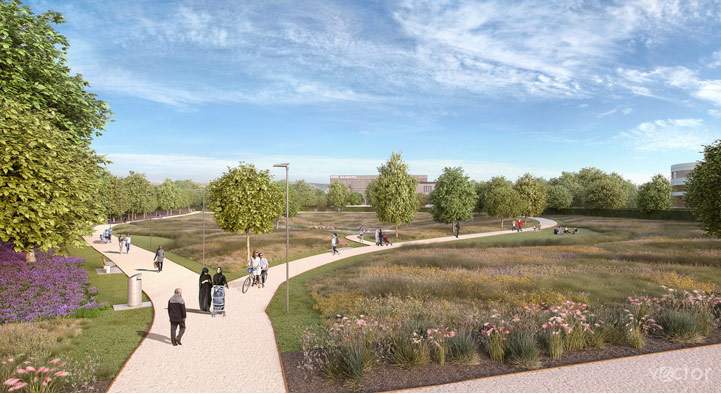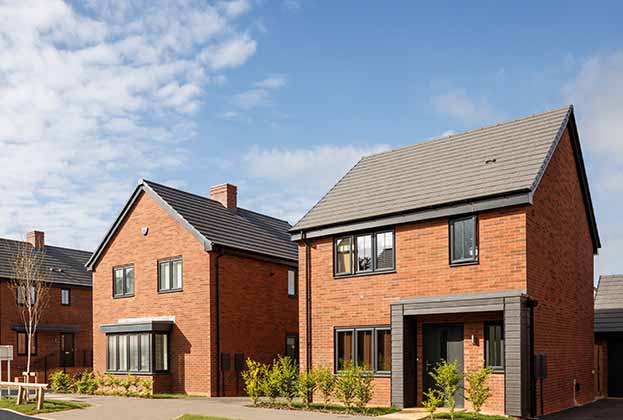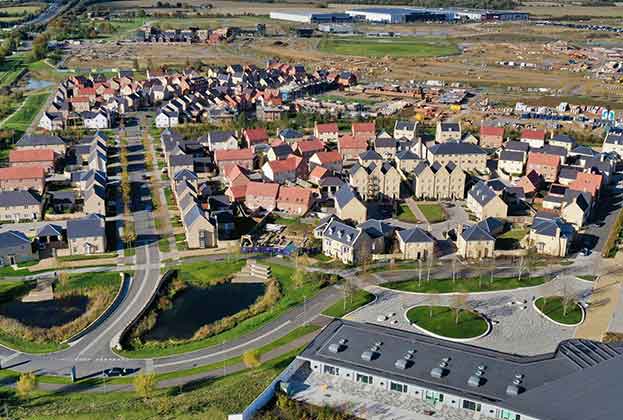How can housebuilders use Build to Rent to increase delivery rates?
Contents
- Why Build to Rent Houses are crucial to delivery of large mixed tenure sites
- Case Study: North Horsham
- How is affordable housing delivered on Build to Rent Housing sites?
- Case Study: Bilston Urban Village
- How does build to rent housing accelerate housing delivery?
- Where are Build to Rent Houses being delivered?
- Why delivery of Build to Rent Houses makes sense to housebuilders?
Why Build to Rent Houses are crucial to the delivery of large mixed tenure sites
Part of investors' ESG strategy for housing is delivering a mix of tenures on sites.
There are very few sites coming forward that are seeking a mixed tenure planning consent. With an increasing proportion of the planning pipeline coming through as large sites, there is more that could be done to help deliver mixed tenure developments.
Proactive local authorities that identify a range of housing needs within their local plan should logically earmark sites for delivery of the identified tenures. This could take the form of identifying sites for mixed tenure delivery where there is a clear variety of housing needs.
From a delivery perspective, land that is intended to deliver a mixed tenure scheme will produce a different land value to a site delivering private for sale with the associated affordable housing.
If local authorities identify ‘need’ in the way that Horsham has done, land bidding and land competition will reflect the value of the mix of tenures.
One of the benefits of mixed-tenure developments is that it allows households to move between tenures as their circumstances change, while staying within their community.
Case Study: North Horsham
The North Horsham masterplan is a 500- plus acre multi-tenure development site in Horsham, West Sussex. The site has outline consent to deliver 2,750 new homes over three phases.
Alongside homes for open market sale, the scheme will deliver single family housing, Later Living accommodation and Affordable Housing (Social Rent, Affordable Rent and Shared Ownership).
Horsham Local Authority needs affordable homes for rent, with a specific need identified in the Local Plan: The cost of housing is high which can make it hard for [families] to stay or move back to the District. There will be a high proportion of two- and three-bed houses delivered which are well-suited for families, across a range of price points.
Homes delivered on-site will meet demand from a range of household types, income brackets and age groups. The various tenures will co-exist, promoting a strong sense of community and social cohesion.
.jpg)
How is affordable housing delivered on Build to Rent Housing sites?
The stakeholders we surveyed did not fully understand how to treat Affordable Housing on single family housing developments. There is an element of misunderstanding around its delivery and what the potential impact may be on the delivery of social and affordable rent.
The main concerns were around the covenant, Discounted Market Rent (DMR) and the duration (in perpetuity).
DMR is understood as an appropriate form of affordable provision on build-to-rent developments, and the rents are frequently set at different levels to allow for a range of household incomes (and housing needs) to be accommodated.
However, local authorities were concerned that over time, the DMR would switch back to market rent rather than another form of Affordable Housing.
Two options for delivering Affordable Housing in the context of Build to Rent Houses:
- Discounted Market Rent where the rent is up to 80% of local market rents and the units are provided throughout the development (often grouped in specific cores/floors) that are owned and managed by the investor with no nomination rights to the local authority.
- Provide traditional 'Affordable Rent' where the rent is up to 80% and meets the local housing allowance. Taking this approach would meet Affordable Housing requirements where the units would be transferred to a Housing Association and the rent is capped at Local Housing Allowance, inclusive of service charges.
Affordable Rent and other traditional low-cost rented homes are subject to nominations and provision on-site will need to consider the design requirements, such as separate cores, to enable the RPs to manage effectively.
Case Study: Bilston Urban Village
One of the best examples of the acceleration benefits SFH can provide is Bilston Urban Village, three miles south-east of Wolverhampton.
Bilston Urban Village is a major initiative to build 420 new homes on a former piece of derelict brownfield land immediately to the south of Bilston, one of the major urban areas in the north-west of the Black Country.
The site was delivered by Countryside with 46% of homes for private sale, 25% of homes being affordable, and was sold to Accord Housing. The final 29% were forward funded by Sigma Capital / PRS REIT.
Sales commenced in Spring 2019 with the site complete and sold by mid-2021. It took just over two years to absorb 420 units into the local market (four homes per week), showing the efficiency of a tri-tenure approach.
The market rent homes were handed over between June 2020 and April 2021. The pace of letting kept up with the pace of delivery and the last unit was let twelve days after it was handed over.

How does build to rent housing accelerate housing delivery?
SFH accelerates housing delivery, especially on large sites. By delivering SFH homes alongside homes for sale, the pace of delivery can increase. Housebuilders recognise the long-term role SFH can play in de-risking and accelerating large sites.
SFH is complementary to open market sales because the homes are not competing for the same demand pool. It allows housebuilders to continue to deliver homes to buyers whilst also delivering homes to investors.
SFH speeds up development, which reduces costs. It also effectively creates sales of homes before they are constructed, which reduces development risk.
On large sites, SFH can allow an increase in delivery rates over and above the normal annual target for open market sales. The need to take a multi-tenure approach to housing development was identified as critical to accelerating housing delivery in the Letwin Review.
The pace of absorption of rental homes is also faster than sales. Private sales are seasonal with faster sales at certain times of the year. SFH is not impacted in the same way and can offer greater consistency.
Where are Build to Rent Houses being delivered?
There are many viable locations for housebuilders to deliver single family homes. Single family homes were initially heavily concentrated in the North West, within commuting distance of Liverpool and Manchester, but development has expanded South.
There are now homes under construction in the West Midlands and the southern regions. Countryside has been responsible for completing the most SFH units in England and Wales.
Single family housing should eclipse multifamily in scale. There are an infinite number of locations where you can deliver between 50 and 100 homes. It is a more scalable sector
Jacqui Daly, Director, Residential Research
SFH currently makes up a tiny fraction of new build stock – it has averaged 0.5% of annual new completions since Q1 2017.
The amount invested into SFH in 2023 suggests we will see the proportion of completions increase in the coming years, though this depends on the pace of delivery.
Larger housebuilders are more likely to be delivering at a scale that can incorporate SFH into mixed tenure sites.
The ideal minimum size for institutional investors is 80 to 100 units on a site, which is more likely to come from a large housebuilder.
The majority of units in Joint Ventures or partnerships have come where large housebuilders are the deliverers.
Additionally, in later-term Forward Purchase deals, large housebuilders are more likely to have stock available on larger sites where they are delivering 500+ homes.
Institutional buyers are less likely to seek small numbers of homes on a site, unless there are multiple sites within the same area, because this leads to higher management costs.
Why delivery of Build to Rent Houses makes sense to housebuilders?
Housebuilders articulated to us clearly why delivering to investors makes sense for them in both the short and long term: they are looking for sustainable pools of housing demand. Institutional PRS is ideally placed to tap into private rental income given the pressure facing small and individual landlords.
For housebuilders, the cost savings which can be factored into the pricing in terms of interest payments are significant. Diversifying the source of funds is also a key attraction of the PRS delivery route.
The efficiency savings through PRS in terms of overheads and the visibility of an order book provide a cushion, especially during economic turbulence.
Delivery of PRS is also a faster asset turn model for housebuilders than private for sale. This means there is an ability to make a margin which may not be as high as private for sale but once all the other costs are factored in it becomes competitive.
The Bank of Mum and Dad (BOMAD) and extending the mortgage length can only go so far to help first-time buyers
Jacqui Daly, Director, Residential Research
.jpg)
- Institutional PRS makes sense at 20% to 40% of a site.
- A guaranteed sale to a PRS investor accelerates delivery – PRS is completed quickly, which helps to establish occupancy and scale.
- There will still be a ‘need’ for rental stock when market conditions improve because of the unaffordability of buying.
- Housebuilders are seeking to be aligned with central and local government policies by proving a diverse mix of tenures.
- On larger sites (500+ units), in theory, there should be a place for PRS with a significant upside to housebuilder’s return on capital employed where the PRS benefits the expenditure on infrastructure and placemaking.
By default, there is an opportunity and demand for institutions to deploy capital into the space
Jacqui Daly, Director, Residential Research
Read the other articles within The Future of Build to Rent Houses – Summary Report below
.jpg)

